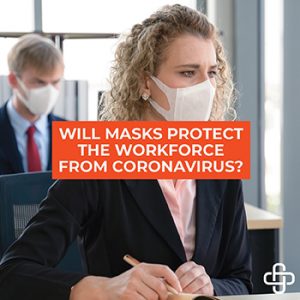
As the coronavirus outbreak continues to spread around the globe including the United States, employers are actively seeking solutions to prevent the spread of disease. Given the coronavirus disease (COVID-19) is a respiratory illness that can spread from person to person, now is the time to understand and address frequently asked questions about respirators and their use.
Should Respirators be Worn in Public?
The CDC does not recommend the routine use of respirators in public. Most often, the spread of respiratory viruses from person-to-person happens among close contacts (within 6 feet).
CDC recommends everyday preventive actions to prevent the spread of respiratory viruses, such as:
- Avoid people who are sick.
- Avoid touching your eyes or nose, and covering your cough or sneeze with a tissue.
- People who are sick should stay home and not go into crowded public places or visit people in hospitals. Workers who are sick should follow CDC guidelines and stay home when they are sick.
What are Respirators?
A respirator is a personal protective device that is worn on the face or head and covers at least the nose and mouth. A respirator is used to reduce the wearer’s risk of inhaling hazardous airborne particles (including infectious agents), gases or vapors. Respirators, including those intended for use in healthcare settings, are certified by the CDC/NIOSH.
What makes N95 Respirators Different from Facemasks/Surgical Masks?
- N95 respirators reduce the wearer’s exposure to airborne particles, from small particle aerosols to large droplets. N95 respirators are tight-fitting respirators that filter out at least 95% of particles in the air, including large and small particles.
- Not everyone is able to wear a respirator due to medical conditions that may be made worse when breathing through a respirator. Before using a respirator or getting fit-tested, workers must have a medical evaluation to make sure that they are able to wear a respirator safely.
- Achieving an adequate seal to the face is essential. United States regulations require that workers undergo an annual fit test and conduct a user seal check each time the respirator is used. Workers must pass a fit test to confirm a proper seal before using a respirator in the workplace.
- When properly fitted and worn, minimal leakage occurs around edges of the respirator when the user inhales. This means almost all of the air is directed through the filter media.
- Unlike NIOSH-approved N95s, facemasks are loose-fitting and provide only barrier protection against droplets, including large respiratory particles. No fit testing or seal check is necessary with facemasks. Most facemasks do not effectively filter small particles from the air and do not prevent leakage around the edge of the mask when the user inhales.
- The role of facemasks is for patient source control, to prevent contamination of the surrounding area when a person coughs or sneezes. Patients with confirmed or suspected COVID-19 should wear a facemask until they are isolated in a hospital or at home. The patient does not need to wear a facemask while isolated.
FREE EBOOK GUIDE
CORONAVIRUS (COVID-19)
What You Need to Know to Protect the Workplace










